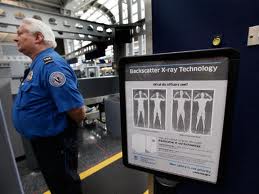 According to a statement published by consumer advocacy group FlyersRights.org, which boast more than 50,000 members, the most recent terrorist bombing plot in Yemen likely not have been detected by airport full body screening devices. The bomb, like the one used by Umar Farouk Abdulmutallab, known as the underwear bomber from his Christmas 2009 attempt to blow up Northwest Airlines Flight 253, was refined from that early version and is currently in the possession of the FBI for examination.
According to a statement published by consumer advocacy group FlyersRights.org, which boast more than 50,000 members, the most recent terrorist bombing plot in Yemen likely not have been detected by airport full body screening devices. The bomb, like the one used by Umar Farouk Abdulmutallab, known as the underwear bomber from his Christmas 2009 attempt to blow up Northwest Airlines Flight 253, was refined from that early version and is currently in the possession of the FBI for examination.
The use of an underwear bomb, as it is called, was most recently attempted, but foiled by agents in Yemen just a few weeks ago. FlyersRights.org points out that while the TSA continues to, in their words, “mislead the public about the efficacy of body scanners in detecting (such) devices,” the group says that the scanners would not have detected the most recent underwear bomb.
“The salient question is whether or not the body scanners would have detected an underpants bomb; and the answer is, ‘No’,” said Kate Hanni, Founder and Executive Director of FlyersRights.org. “If the scanners could have detected these low density explosives inside underpants, the TSA would be able to demonstrate this to the public, but they haven’t done it. Either they haven’t tested the equipment for this type of bomb, or if they have, they don’t want us to know the results.”
Hanni also noted that Senator Dianne Feinstein, after a recent intelligence briefing, reported that the device would have been “undetectable.”
Hanni cited as evidence a YouTube video in which a demonstration of the Rapiscan Backscatter Body Scanner failed when trying detect low density powdered explosives, liquid slurries, or detonators.
“The public needs to know the limitations of the TSA screenings, and particularly those of Rapiscan’s body scanners. This technology has not been shown to be effective at catching devices like the one used by Abdulmutallab or in this most recent plot.” Hanni continued, “Rapiscan’s own website says that its machines cannot detect anything more than one-tenth of an inch below the skin’s surface, which means they cannot detect cavity bombs or implant bombs. By glossing over these important distinctions, it is clear the TSA is more concerned with lulling our citizens into accepting the use of these machines in highly invasive searches, even though TSA knows they have not been shown to be effective. In fact, no terrorist has ever been caught at a TSA checkpoint.”
SOURCE FlyersRights.org
![Herbal Reference Substances are Key to Everyday Products <!-- AddThis Sharing Buttons above -->
<div class="addthis_toolbox addthis_default_style " addthis:url='http://newstaar.com/herbal-reference-substances-are-key-to-everyday-products/3512112/' >
<a class="addthis_button_facebook_like" fb:like:layout="button_count"></a>
<a class="addthis_button_tweet"></a>
<a class="addthis_button_pinterest_pinit"></a>
<a class="addthis_counter addthis_pill_style"></a>
</div>When it comes to quality control testing and the development of new products, Botanical Reference Materials (BRMs), also known as Herbal References are critically important. To help companies ultimately obtain all-important FDA approval, the Food and Drug Administration provides in its guidance a recommendation that […]<!-- AddThis Sharing Buttons below -->
<div class="addthis_toolbox addthis_default_style addthis_32x32_style" addthis:url='http://newstaar.com/herbal-reference-substances-are-key-to-everyday-products/3512112/' >
<a class="addthis_button_preferred_1"></a>
<a class="addthis_button_preferred_2"></a>
<a class="addthis_button_preferred_3"></a>
<a class="addthis_button_preferred_4"></a>
<a class="addthis_button_compact"></a>
<a class="addthis_counter addthis_bubble_style"></a>
</div>](http://newstaar.com/wp-content/uploads/2021/02/Achillea_millefolium_flowers-100x100.jpg)
![Quality Electrochemical Biosensors are Critical for Medical, Food and Chemical Industry <!-- AddThis Sharing Buttons above -->
<div class="addthis_toolbox addthis_default_style " addthis:url='http://newstaar.com/quality-electrochemical-biosensors-are-critical-for-medical-food-and-chemical-industry/3512086/' >
<a class="addthis_button_facebook_like" fb:like:layout="button_count"></a>
<a class="addthis_button_tweet"></a>
<a class="addthis_button_pinterest_pinit"></a>
<a class="addthis_counter addthis_pill_style"></a>
</div>A number of industries have, at their core, a need to frequent or even continuous analysis of biological media. These include the medical and pharmaceutical fields, biotech firms, and food and chemical companies. To maintain quality standards and develop new products, these industries rely heavily […]<!-- AddThis Sharing Buttons below -->
<div class="addthis_toolbox addthis_default_style addthis_32x32_style" addthis:url='http://newstaar.com/quality-electrochemical-biosensors-are-critical-for-medical-food-and-chemical-industry/3512086/' >
<a class="addthis_button_preferred_1"></a>
<a class="addthis_button_preferred_2"></a>
<a class="addthis_button_preferred_3"></a>
<a class="addthis_button_preferred_4"></a>
<a class="addthis_button_compact"></a>
<a class="addthis_counter addthis_bubble_style"></a>
</div>](http://newstaar.com/wp-content/uploads/2020/10/Electrochemical-Biosensor-100x100.jpg)
![Company Develops Industrial Mixers Well-Suited for both Fragile and Explosive Products <!-- AddThis Sharing Buttons above -->
<div class="addthis_toolbox addthis_default_style " addthis:url='http://newstaar.com/company-develops-industrial-mixers-well-suited-for-both-fragile-and-explosive-products/3512071/' >
<a class="addthis_button_facebook_like" fb:like:layout="button_count"></a>
<a class="addthis_button_tweet"></a>
<a class="addthis_button_pinterest_pinit"></a>
<a class="addthis_counter addthis_pill_style"></a>
</div>Industrial drum mixers are normally applied to blend mixes of varying viscosities such as adhesive slurries or cement. Some of these mixers have the capability of blending mixes of very different particle sizes such as fruit and ice cream, and gravel and cement slurry. The […]<!-- AddThis Sharing Buttons below -->
<div class="addthis_toolbox addthis_default_style addthis_32x32_style" addthis:url='http://newstaar.com/company-develops-industrial-mixers-well-suited-for-both-fragile-and-explosive-products/3512071/' >
<a class="addthis_button_preferred_1"></a>
<a class="addthis_button_preferred_2"></a>
<a class="addthis_button_preferred_3"></a>
<a class="addthis_button_preferred_4"></a>
<a class="addthis_button_compact"></a>
<a class="addthis_counter addthis_bubble_style"></a>
</div>](http://newstaar.com/wp-content/uploads/2020/06/bandeau-sofragir2-100x100.jpg)